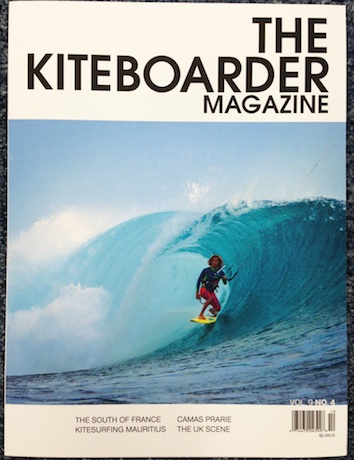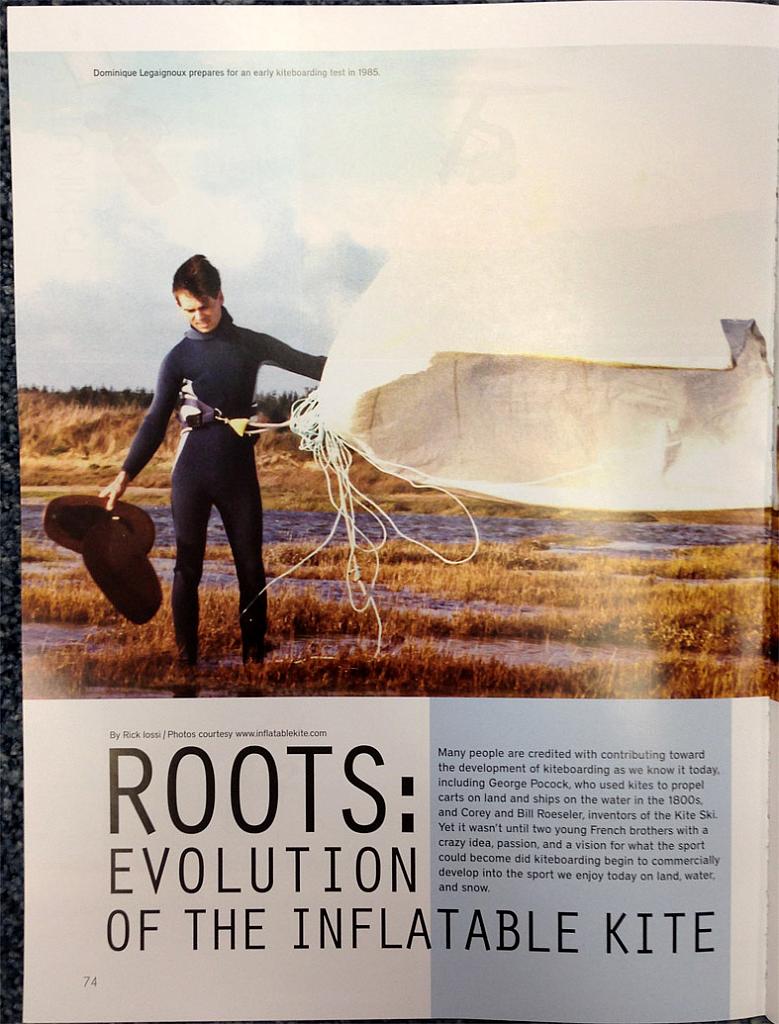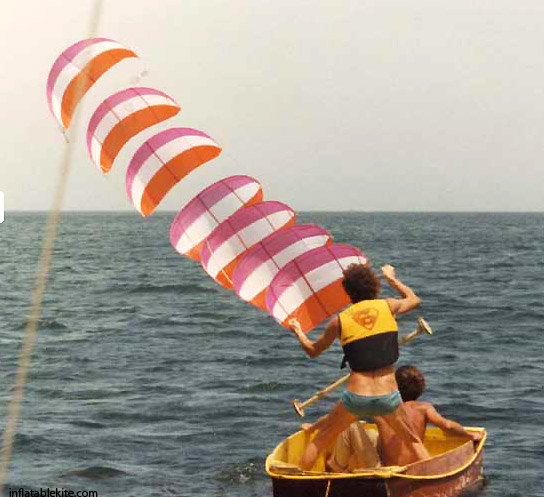
 |
|

|
||||||
 |
|
|
Thread Tools | Display Modes |
|
#1
|
||||
|
||||
 The Kiteboarder Magazine recently asked me to interview Bruno Legaignoux about the evolution of the inflatable kite. The following article in the current issue is what came out of it. In many ways, the design team of Bruno and his brother Dominique are in large measure responsible for key aspects of popular kitesurfing as we know it today. At least the part of kitesurfing that uses inflatable kites which dominates things at present. Many kiters participated in the evolution with each new product that hit the streets over the years from the brothers. I can still recall my first Wipika Classic 8.5 m kite from August 1998 and all the innovations that followed from their other design patents dealing with four line C kites, BOW kites and still more. That and all the countless fun hours ripping over the water and boosting above it. Many others have brought important designs and concepts to kitesurfing over the years bringing the wide diversity of form and function to the sport that we enjoy today. None of this is to underplay all that important work in kitesurfing. This article focuses on the contribution of the Legaignoux brothers. I feel a debt of gratitude to the brothers as a result and wanted to take particular care with this article. I communicated with Bruno in the last couple of weeks before his departure on a major voyage. It was great that he found the time to answer numerous questions and forward historical photos for the piece before his departure despite all the pressures of trip preparation. The first page of the five page article is reproduced below. The article tracks their developments, some of the thought processes, setbacks and mile posts along the way.  Brother Dominque comes across the marsh with the forebearer of modern inflatable kites patented in 1985. Pickup a piece of history and checkout this issue of The Kiteboarder Magazine, (Vol. 9 No. 4), http://www.thekiteboarder.com. .
__________________
FKA, Inc. transcribed by: Rick Iossi Last edited by ricki; 01-09-2013 at 08:44 PM. |
|
#2
|
||||
|
||||
|
The article will provide some background on this strange but very important scene in inflatable kite evolution:
 and explain such mysteries as the purpose and derivation out of need of these strange objects:  When you innovate, you have to start somewhere, our sport evolved from this. These unusual stories and more in this issue of The Kiteboarder Magazine, (Vol. 9 No. 4), http://www.thekiteboarder.com. .
__________________
FKA, Inc. transcribed by: Rick Iossi |
|
#3
|
||||
|
||||
|
Here is the complete text of the article and insight on how much the brothers brought to our sport repeatedly over the years.
"ROOTS: EVOLUTION OF THE INFLATABLE KITE By Rick Iossi Many people are credited with contributing toward the development of kiteboarding as we know it today, starting with George Po**** in the 1800s who used kites of increased size to propel carts on land and ships on the water using a four-line control system, to Corey and Bill Roeseler, inventors of the Kite Ski. Yet it wasnât until two young French brothers in their twenties with a passion and vision for what the sport could be patented their kite design in 1985 that kiteboarding started to commercially develop into the sport we enjoy today on land, water and snowâ¦. Bruno and Dominique Legaignoux became immersed in watersports and competitive sailing at the early age of ten in Brittany, France. They won the French National Junior Dingy Sailing Championship in 1979 and spent their free time sailing, surfing, and windsurfing. Bruno was so focused on sailing that he dropped out of college at 18 to become a sailing instructor. Their interest in sailing fast led them to work on prototype devices for speed sailing including thick sails with a wing-like deep camber to create more lift. The Legaignoux brothers also experimented with a wide variety of speed hulls and boards for many years without much success. In 1984 at the Brest International Speed Week in Brittany, France, they saw Jacobs Ladder, a custom-designed catamaran from the UK pulled by a stack of two-line Flexifoil foil kites. Immediately they thought they had just seen the future of speed sailing and began to think about ways of using kites. Back then it took three people to launch the stack of kites. They didnât relaunch from the water, and they didnât go upwind very well, so they sat down and began to work out how to overcome these problems. Bruno and Dominque left on an around-the-world sailboat trip and cruised around while beginning to experiment with kite propulsion. The brothers started by pulling their sailing dingy with a stack of a dozen of their own home-built 0.5m carbon fiber-framed kites and then moved on to trying to pull themselves on skis and boards. They quickly found out water skis were more efficient and easier to get up on than a single board with these kites. Although they thought there might be a market for kite propulsion in boating, they chose to start with trying to develop kites to pull water skis, a board, or whatever they could find that was short, light, and fast. âThe first time I used kites with skis was in 1984 in Brittany, France,â said Bruno. âI wasn't able to go upwind but at least I could go back and forth at good speeds without much trouble. We were happy but knew we had a long way to go.â They tried putting foam in different places on their early kites to make them able to relaunch from the water but that didn't help. To keep themselves focused, the brothers created a list of performance goals for their kites. They wanted their kites to be water relaunchable, stable, and speedy to improve handling. They wanted a simple, aerodynamic, and durable kite to optimize performance and reduce downtime for repairs. They put their sailing trip on hold and focused their energies on testing and developing kites through trial and error. After being unable to relaunch their stacked kites from the water after months of trying, they decided to use one large kite. They realized the single large kite would need a heavy frame to hold its shape, so they came up with the idea to try an inflated frame to keep the kite rigid. Bruno and Dominique learned that a C-shaped kite could be strong, stable, and light, but the breakthrough was when they discovered it could relaunch from the water relatively easily when combined with a rigid inflatable framework. The very first prototype leading edge inflatable kite was a 5m kite built in October of 1984. âA two-line C-kite without bridles required so much steering travel with a long bar that it wasn't practical,â said Bruno. âWe tried using a pulley attached to the harness with one line going from wingtip to wingtip through the pulley, but this was really awkward as we had to pull the line pretty far to get the kite to turn.â Immediately realizing they were on to something big, they filed their first USA patent in 1985 for a Propulsive Wing with Inflatable Armature. This obscure-sounding patent title was basically the starting point for what we all fly today. It was a two-line kite with an inflated leading edge and inflated battens, similar in shape to the original Wipika Classic kite that would be released more than ten years later. Bruno and Dominque showed off their invention during the 1985 Brest International Speed Week and won the Ingenuity Prize. They only managed to clock a 17 knot speed at the event but they returned the next year and beat most of the windsurfers while hitting 15 knots of speed in only 10 knots of wind. In 1985 the brothers were convinced that this new sport had the potential to become larger than windsurfing due to the small size, light weight, and low cost of the equipment. They knew that they could jump very high and far and also believed that a kite would one day become the fastest sailing craft on earth. It's important to remember that common use of the internet was still a long ways away at this time. The immediate exchange of ideas we enjoy today were exchanged by mail. To communicate with someone in the US they had to wait two to three weeks each way for a letter to cross the Atlantic and back. âDuring the first five years, a few people showed interest in the concept but no one really appreciated the importance of the shape of the kite itself,â said Bruno. âAt the time windsurfing was a very strong, dominant watersport with 400,000 sails being sold each year. The windsurfing brands were making a lot of money and were not interested in developing a new sport. To most people, we were just a couple of crazy guys. We didn't even know what to call it and were just using the French names planche Ã* cerf-volant (windsurf kiting) or ski Ã* cerf-volant (ski kiting). It wasn't until 1995 that Manu Bertin suggested we call it flysurfing, so the names kitesurfing and kiteboarding were a long way off.â While Bruno and Dominique were confident in their kite, it took more than a decade to develop a commercial product that was ready to be sold. âOver the first ten years we were focused on developing the kite and making it more stable,â said Bruno. âWe also looked at other possible markets for the kite such as dune jumping, rescue at sea, small craft propulsion, etc. We knew it would be hard to grow kitesurfing with windsurfing still such a strong sport. We talked about abandoning the kite at times but the progress we made each year kept us going.â From 1991 to 1994 the Legaignouxs created and developed WIPICAT, an inflatable craft that could be pulled with their kite aimed at the general market. The WIPICAT kite was an 8.5m kite flown on 6.5m lines and packaged with an inflatable craft the rider laid on. It was not a successful product. At the same time windsurfing's popularity was beginning to decline and some windsurfers starting to take a closer look at what the Legaignouxs were doing. Manu Bertin contacted them towards the end of 1994 and they sent a few kites to him in Hawaii. Laird Hamilton got his hands on one of the kites and over the next few years things accelerated quickly as other legendary Hawaiian waterman became interested in kiting. Frustrated that they hadn't been able to find an existing brand to license their kite patent to, the brothers formed the Wipika (Wind Powered Inflatable Kite Aircraft) brand in 1995. In 1998 Naish approached them about licensing their kite patent. âThat's when things really happened quick,â said Bruno. âWe had 13 years of kite development behind us while the windsurfing or paragliding designers were just getting started. The year after Naish became a licensee, I designed 60 kites for 8 different brands anxious to enter the kitesurfing market ASAP. That winter the office was more of a plan factory than a kite R&D department.â Soon after, Bruno began to experiment with four-line bridleless kites. âAfter a few tests the advantages of a four-line kite were obvious, but we were concerned about introducing four-line kites to the market too soon. It seems silly now, but we were worried that four lines would be too overwhelming to people not used to dealing with kites and lines. We felt the larger wind range offered by a four-line kite meant more safety, and that was the main reason for bringing it to the market.â Two years later they were concerned about accidents they were hearing about so they focused on creating kites with even more depowering ability. In 2000 the brothers moved to the Dominican Republic to continue their kite development and work on developing kites with extremely high depower. âWe began working on the BOW concept in 2000-2001,â said Bruno. âWe were concerned we might not be able to get a patent for the BOW concept and we would lose royalties from the C-kite if the BOW kite was successful, but we moved forward because we really thought the BOW kite would save lives.â They created the first BOW kite in 2002 by modifying a Wipika Freeair by adding bridle lines and changing its shape. The brothers were successful in receiving a number of patents for their BOW kite concepts, with the main BOW kite patent having been applied in 2004 under the title Wing Having a Negative Dihedron for Towing a Load. The brothers first demonstrated the BOW kite design to Takoon, a company they were involved with. Bruno pushed to get the BOW kite on the market as soon as possible but met resistance. In mid-2004 he decided to present the concept to other companies and Cabrinha's team was enthusiastic about the BOW kite idea. Takoon and Cabrinha released their first BOW kites to the kiteboarding market in August 2005 and soon after similar kites from other brands started to show up in the marketplace. When asked about what he would have done differently, Bruno said, âIt would have been difficult to dream up a better direction for the sport. Kites have driven the fastest sailing craft on earth, provided an easy way to surf waves, and was briefly selected for the Olympics. I've always thought kitesurfing would have a wider appeal than what windsurfing had in its best years, we just haven't found effective ways to make the sport more accessible to the general public.â As I was talking to Bruno for this story he was getting ready to continue the circumnavigation he put on hold when the Legaignouxs began making kites. âIn 1984 we put our sailing circumnavigation on hold to develop kites. Our original goal was to make a little money and get back to sailing after a few years. Those few years stretched into more than two decades. Time will tell if I finish the trip this time.â For more photos and info about the history of the inflatable kite, visit http://inflatablekite.com."
__________________
FKA, Inc. transcribed by: Rick Iossi |
|
#4
|
|||
|
|||
|
Nice job, Rick. I really enjoyed reading this article. Great historical info. Amazing how quickly the sport has evolved. Thanks for posting this.
Jim McIntosh Central Fla./OBX |
|
#5
|
||||
|
||||
|
Thank you for commenting Jim, much appreciated! It turned out to be a bigger project than I originally thought it would be. Ended up spending a lot of time doing research. What a contribution from just two guys to a global sport!
__________________
FKA, Inc. transcribed by: Rick Iossi |
 |
|
|